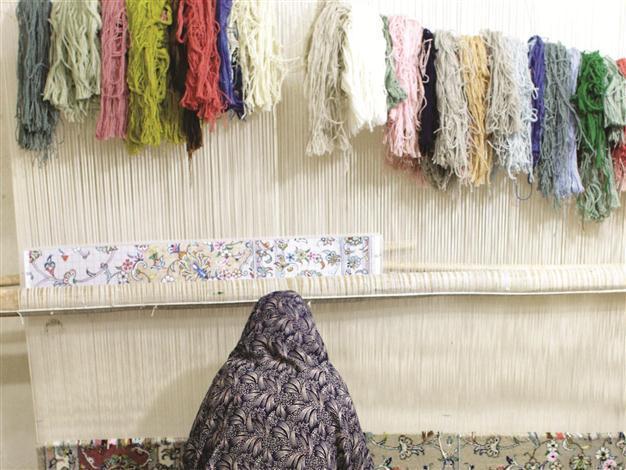Iran weaves technology into its Persian carpets
ISFAHAN, Iran - Agence France-Press

Iranian women weave carpets at a workshop in
Isfahan (R). A genuine handmade Persian carpet can cost thousands or tens of thousands of dollars. AFP Photo
Zahra Nazer’s fingers work deftly on the loom, rapidly weaving each colorful silk thread into a carpet that will take more than a year to complete.
The practised, swift movements and the loom, strung up on rough-hewn wooden rods, are ages-old, virtually unchanged in the more than 2,500 years that Persian carpets have been coming out of what is today’s Iran. But the industry, worth half a billion dollars in exports, has come under threat in recent years and is responding by introducing some radical transformations, effectively replacing tradition with 21st-century technology.
Nazer sees her profession, which counts 200,000 registered weavers, including her mother, father and aunts, as an inherited one passed from one generation to the next since time immemorial.
“I’m 18, and I have been weaving since I was 15,” Nazer said. “I like weaving and it’s not that hard unless one does too much of it.”
What she does not see, though, is the changing market outside her cosy workshop shared with dozens of other women.There, cheaper imitations of what she makes are flooding in from China and Pakistan, many of them machine-weaved.
The number of buyers is dwindling, put off by rising prices for the carpets, largely a result of soaring silk costs.A genuine, good-quality handmade Persian carpet can cost thousands or tens of thousands of dollars.
Weavers like Nazer, though, receive less than a dollar a day for their painstaking work. That reflects the narrow profit margins, including in the ancient bazaars where piles of ornate coverings are piled on top of each other, waiting for prospective customers.
“The situation in the market has worsened drastically in the past few years, due to the lack of buyers, especially since our carpets’ (target) customers are tourists and we need more tourists in the country,” said Hassan Hosseinzadeh, a carpet seller attending an exhibition of the wares in the central city of Isfahan.
Computers are faster To counter the decline, some carpet businesses have turned to computers and machinery to claw back their place in the market.
One firm, in the city of Qom, has a young designer, Javad Dejahany, sitting in front of a desktop PC connected to a drawing tablet.
He uses the device to sketch out the intricate patterns of lines and flowers and birds that will be set into the carpet by the female weavers. Next to him sits an older worker determinedly doing the work the old-fashioned way: by hand, on grid paper.
“Some people have been designing for years and are still working by hand. Those in their 60s have no interest in computers. Why? One has to keep pace with science, otherwise one becomes 100% isolated,” Dejahany said.
The computer, he explained, “speeds up designing and allows room for more manoeuvres. Working with the computer is much, much faster than hand-drawn work.”
In Isfahan’s university of art, students pick up in a matter of days techniques their traditional predecessors would have spent months trying to glean from their elders.
“Our methods of academising the traditional way have really sped up teaching,” said a carpet weaving teacher at the university, Ali Reza Iranpour.
He pointed out as an example the work of one student that he said matched the quality of old masters, all from just six hours a week of weaving classes.
